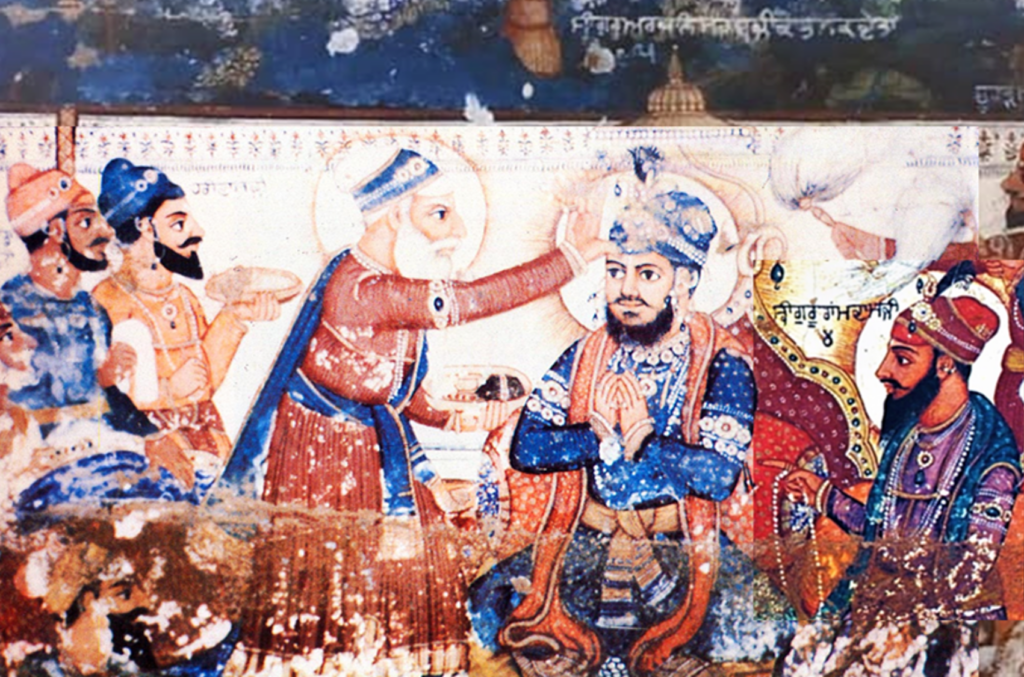
ਸੰਝੈ ਸੋਦਰੁ ਗਾਵਣਾ ਮਨ ਮੇਲੀ ਕਰਿ ਮੇਲਿ ਮਿਲੰਦੇ। ਰਾਤੀ ਕੀਰਤਿ ਸੋਹਿਲਾ, ਕਰਿ ਆਰਤੀ, ਪਰਸਾਦ ਵੰਡੰਦੇ।
Around sunset, in the evening, sing Sodar and heartily associate with one another. At night time, [recite] the Keerat (praises of the lord) Sohila, perform the Aarti (ceremony of waving lamps), [then] share/distribute the Parshad.
Bhai Gurdas Ji’s Vaaran – Vaar 6, Pauri 3
Aarti (or Aarti-Aarta) is a beautiful time-honoured Khalsa practice. A glance into our heritage (such as in the old mural painting shown above) reveals that the practice has been an important part of the Sikh tradition right from the time of the Gurus. Sri Harimandir Sahib in Amritsar and the Takht Sahibs in Punjab had maintained the practice up until the colonial-era. With changing attitudes the tradition began to disappear (around the 1920s). Along with many other Puratan Khalsa traditions, Aarti-Aarta has remained intact outside of Punjab at Takht Sachkhand Sri Hazur Sahib in Nanded, Maharashtra and Takht Sri Patna Sahib Harimandir in Patna, Bihar. In addition to the Gurdwaras near those Takht Sahibs, Aarti-Aarta is also been maintained at some other non-mainstream Gurdwaras. Nihang Dals prominently maintain Aarti-Aarta in Punjab and Gurdwaras managed by the Dal Panth (Nihang Groups) carry out the practice in accordance with their Maryadas.
ਅਰ ਜੋ ਤਖਤ ਖਾਲਸਾ ਚਾਰੇ। ਫਡੇ ਵਡੇ ਜੋਈ ਗੁਰਦੁਆਰੇ॥ ਵਿੱਚ ਉਨ੍ਹਾਂ ਦੇ ਹੁੰਦੀ ਦੇਖੀ। ਫਿਰ ਤੇਰੀ ਕਿਆ ਕਰਦੀ ਸੇਖੀ॥ ਅੰਮ੍ਰਿਤਸਰ ਜੀ ਦੇ ਦਰਬਾਰ। ਹੋਇ ਆਰਤੀ ਥਾਲ ਮਝਾਰ॥
The Four Takhts* of the Khalsa, which are massive Gurdwaras. I have seen it (Aarti) be performed there. Then what can your wild claims do? In the Darbar (Harimandir Sahib) of Amritsar Ji, Aarti takes place inside on a platter.
(Gurmat Aarti Parbodh – Giani Ditt Singh – 1900 CE)
Sardar Sundar Singh Ramgarhia’s detailed account on the daily routine of Sri Harimandir Sahib (“Golden Temple”) in 1903 CE describes the Aarti ceremony taking place in the evening. The Aarti Kirtan still remains even today, but the ceremonial aspects of Aarti are now long gone. The regal ceremony of lit lamps being decorated on a platter, and then waved in front of Guru Granth Sahib Ji with respect and humility is no longer conducted at Harimandir Sahib.
At evening the Evening prayer (rahras) is begun by the musicians (rababis) and finished by the Granthi. This is succeeded by the ceremony of Arti, during which lighted lamps are waved before the Sacred Book, and this again is followed by a procession and singing of hymms round the shrine, known as chauki. Later on the Granthi again opens the book and reads a stanza; after which the prayer of rest (sohila) is sung, and the Book is taken back to the Akal Bunga with great solemnity.
(Guide to the Darbar Sahib or Golden Temple of Amritsar – Page 27 [By: Sardar Sundar Singh Ramgarhia – 1903 CE)
The original Puratan Maryada remains in the Takhts outside of Punjab (Patna Sahib and Hazur Sahib), where Chaur Sewa and the Dhup Deep Aarti Sewa of Guru Granth Sahib Ji still take place simultaneously at the Takht Sahibs and many of the Gurdwaras within their vicinity.